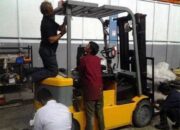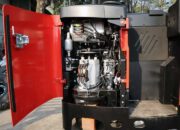Gas or LPG forklifts
Gas forklifts are the best performers and have indoor/outdoor versatility.
LPG (liquefied petroleum gas) forklifts have long been popular due to their competitive prices and suitability for indoor and outdoor use. In addition, it is a popular choice because it is quite convenient for a work environment that revolves around like a clock. The engines are often derivatives of vehicle engines, so parts are available at moderate prices.

Gas forklifts are often “compact” easier to use than diesel forklifts. Due to the compactness of the tires and chassis compared to larger diameter tires and the increased distance between the diesel wheels, this vehicle has been dubbed as a vehicle designed specifically for the yard.
LPG forklifts are quieter to use (dba level at the wheel) than diesel alternatives, but the exhaust fumes are less irritating than diesel fumes. Catalytic converters work more efficiently with LPG compressed air internal combustion engines that have higher temperatures than with diesel ignition engines. The performance characteristics of trucks using LPG are generally higher than those of electric and diesel forklifts. Travel speed, acceleration and lift rates are generally better than other electric/diesel competitors because the power of the engine responds better.
The service weight of gas forklifts is generally lower than that of stability peers such as electric and diesel forklifts. The vibration level of LPG forklifts in the driving position is lower than diesel forklifts but higher than electric forklifts.
Defect
Gas or LPG forklifts are the cheapest to buy new but maintenance and fuel costs are the highest of the three.
In general, of the three types of forklift engines, the residual value of LPG forklifts is probably the lowest compared to electric and diesel engines. Gas forklift has a tendency to be annoying when running on gas but stops suddenly without any advance notice, sometimes it is working away from gas tank store. Usually, it is not a fuel gauge to give the operator an indication of how much gas is in the tank. When the measurement work is done, the difficulty is that the gas is usually in the tank and not in the display (the driver cannot perform regular gas measurements continuously). The pressure switch, shows that the gas in the tank seems to be almost empty and it only gives a warning of 5 to 20 seconds in advance. Like diesel forklifts, LPG forklifts are more susceptible to engine and transmission leaks as they may not be acceptable in some applications.
For example: pharmaceutical industry, food industry… Exhaust fumes can leave a greasy layer of hydrocarbon particles on surfaces around the cargo. This bad luck occurs only in extreme cases where there is no ventilation duct.
Gas and diesel forklifts require a higher skill level of a driver than an electric forklift. The use of pedals or clutches, when lifting/unloading, allows for slow traction and unnecessarily high lift speeds during operation. Since they still run when the engine is idle, LPG and diesel units are often considered more reliable than electric engines, but this makes them more susceptible to abuse if they continue to be used and More serious problems will arise due to lack of regular maintenance.







